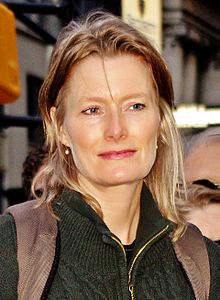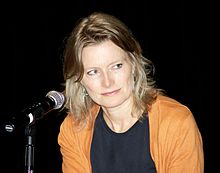Jennifer Egan
Jennifer Egan | |
|---|---|
 Egan at Occupy Wall Street, November 2011 | |
| Born | September 7, 1962 Chicago, Illinois |
| Occupation | novelist |
| Citizenship | United States |
| Alma mater | University of Pennsylvania (BA) Cambridge University (MA) |
| Genre | Fiction, Novel, Short story |
| Notable works | Look at Me (novel, 2001), A Visit from the Goon Squad (novel, 2010) |
| Notable awards | National Endowment for the Arts Fellowship, Guggenheim Fellowship, Pulitzer Prize for Fiction, National Book Critics Circle Award |
| Website | |
| www | |
Jennifer Egan (born September 7, 1962) is an American novelist and short story writer who lives in Fort Greene, Brooklyn. Egan's novel A Visit from the Goon Squad won the 2011 Pulitzer Prize for Fiction and National Book Critics Circle Award for fiction.
Background and career
Egan was born in Chicago, but grew up in San Francisco. After graduating from Lowell High School, she majored in English literature at the University of Pennsylvania. While an undergraduate, Egan dated Steve Jobs, who installed a Macintosh computer in her bedroom.[1] After graduating, Egan spent two years at St John's College, Cambridge supported by a Thouron Award.[2][3] She has published short fiction in The New Yorker, Harper's, Zoetrope: All-Story, and Ploughshares,[4] among other periodicals, and her journalism appears frequently in The New York Times Magazine. She has published one short story collection and four novels, among which Look at Me was a finalist for the National Book Award in 2001.
Egan has been hesitant to classify A Visit from the Goon Squad as either a novel or a short story collection, saying, "I wanted to avoid centrality. I wanted polyphony. I wanted a lateral feeling, not a forward feeling. My ground rules were: every piece has to be very different, from a different point of view. I actually tried to break that rule later; if you make a rule then you also should break it!" The book features genre-bending content such as a chapter entirely formatted as a Microsoft PowerPoint presentation. Of her inspiration and approach to the work, she said, "I don’t experience time as linear. I experience it in layers that seem to coexist...One thing that facilitates that kind of time travel is music, which is why I think music ended up being such an important part of the book. Also, I was reading Proust. He tries, very successfully in some ways, to capture the sense of time passing, the quality of consciousness, and the ways to get around linearity, which is the weird scourge of writing prose." [5]
Awards

Egan received a Thouron Award in 1986.[3] She was the recipient of a National Endowment for the Arts Fellowship, a Guggenheim Fellowship in 1996,[6] and was a fellow at the Dorothy and Lewis B. Cullman Center for Scholars and Writers at the New York Public Library in 2004–2005.[7] In 2011 she was a finalist for the PEN/Faulkner Award for Fiction.[8]
Egan won the 2011 National Book Critics Circle Award (Fiction)[9] and Pulitzer Prize for A Visit from the Goon Squad.[10]
Academic Interpretation
A small but growing body of peer-reviewed academic literary criticism examines Egan's work in a variety of contexts. David Cowart has read Egan's project in A Visit from the Goon Squad as indebted to Modernist writing but as possessing a closer affinity to postmodern writing, in which "she meets the parental postmoderns on their own ground; by the same token, she venerates the grandparental moderns even as she places their mythography under erasure and dismantles their supreme fictions", an aspect also touched upon by Adam Kelly.[11][12] Baoyu Nie has focused, alternatively, on the ways in which "Egan draws the reader into the addressee role" through the use of second-person narrative technique in her Twitter fiction. Finally, Martin Paul Eve has argued that the university itself is given "quantifiably more space within Egan’s work than would be merited under strict societal mimesis", leading him to classify Egan's novels within the history of metafiction.[13] In 2013, the first academic conference event dedicated to Egan's work was held at Birkbeck, University of London, entitled "Invisible Circus: An International Conference on the work of Jennifer Egan".[14]
Partial bibliography
Novels
- The Invisible Circus (1995)
- Look at Me (2001)
- The Keep (2006)
- A Visit from the Goon Squad (2010)
- Manhattan Beach (forthcoming, 2017)
Short fiction
- Emerald City (short story collection) (1993, UK; released in US in 1996)
- Black Box (short story) (2012, US; released on The New Yorker's Twitter account)
Reviews
Reviewing The Keep, The New York Times said: "Jennifer Egan is a refreshingly unclassifiable novelist; she deploys most of the arsenal developed by metafiction writers of the 1960s and refined by more recent authors like William T. Vollmann and David Foster Wallace—but she can’t exactly be counted as one of them. The opening of her novel, The Keep, lays out a whole Escherian architecture, replete with metafictional trapdoors, pitfalls, infinitely receding reflections and trompe l’œil effects, but what’s more immediately striking about this book is its unusually vivid and convincing realism."[15]
See also
References
- ^ Schuessler, Jennifer (3 November 2010). "Inside the List". The New York Times. Retrieved 3 October 2012.
- ^ Mitchell, Margaret (2009), Hamilton, Geoff; Jones, Brian (eds.), Encyclopedia of Contemporary Writers and Their Work, Infobase Publishing, pp. 108–110, ISBN 0-8160-7578-6
- ^ a b Whiteman, Sean (July–August 2011). "Surprises Are Always The Best". The Pennsylvania Gazette. 109 (6).
- ^ "Author Details". Pshares.org. Retrieved 2011-04-20.
- ^ Julavits, Heidi. "Jennifer Egan", BOMB Magazine, Summer 2010. Retrieved 20 July 2011.
- ^ "Jennifer Egan". John Simon Guggenheim Memorial Foundation.
- ^ "Past Fellows". New York Public Library.
- ^ Bosman, Julie, Deborah Eisenberg Wins PEN/Faulkner Award for Fiction, New York Times, March 15, 2011
- ^ Bosman, Julie, Jennifer Egan and Isabel Wilkerson Win National Book Critics Circle Awards, New York Times, March 11, 2011
- ^ Discussion of "A Visit from the Goon Squad" in relation to her work as a whole: Retrieved 20 April 2011.
- ^ Cowart, David (2015-05-27). "Thirteen Ways of Looking: Jennifer Egan's A Visit from the Goon Squad". Critique: Studies in Contemporary Fiction. 56 (3): 252 in 241–254. doi:10.1080/00111619.2014.905448. ISSN 0011-1619.
- ^ Kelly, Adam (2011-09-21). "Beginning with Postmodernism". Twentieth-Century Literature. 57 (3–4): 391–422. doi:10.1215/0041462X-2011-4009. ISSN 0041-462X.
- ^ Eve, Martin Paul. ""Structural Dissatisfaction": Academics on Safari in the Novels of Jennifer Egan". Open Library of Humanities. 1 (1). doi:10.16995/olh.29.
{{cite journal}}: CS1 maint: unflagged free DOI (link) - ^ "Invisible Circus: An International Conference on the work of Jennifer Egan — Department of English and Humanities, Birkbeck, University of London". www.bbk.ac.uk. Retrieved 2016-01-02.
- ^ Madison Smartt Bell (July 30, 2006). "Into the Labyrinth". The New York Times Book Review.
- ^ Emerald City. From "Emerald City". The Short Story Project
Further reading
- Kelly, Adam. "Beginning with Postmodernism." Twentieth-Century Literature 57.3 (Fall 2011): 391-422. [On Look at Me]
- Mishra, Pankaj. "Modernity's Undoing." London Review of Books 33.7 (31 March 2011): 27-30. [On A Visit from the Goon Squad]
External links
- Jennifer Egan's website
- Jennifer Egan at IMDb
- Reviews & Scores for The Keep at Metacritic.com
- Book Review at Boldtype.com
- "The Ghost in the Renovation" at This Old House website
- Reading report from Happy Endings with Peter Behrens and David Rakoff, published at bookishlove.net (Nov 2006)
- 2010 BOMB Magazine interview with Jennifer Egan by Heidi Julavits
- Paul Vidich (Spring 2010). "Jennifer Egan, An Interview". Narrative Magazine.
- Jennifer Egan: Chronological Bibliography of First Editions
- 1962 births
- Living people
- 20th-century American novelists
- American women short story writers
- Writers from San Francisco
- Writers from Brooklyn
- Pulitzer Prize for Fiction winners
- University of Pennsylvania alumni
- Alumni of St John's College, Cambridge
- Writers from Chicago
- National Endowment for the Arts Fellows
- Guggenheim Fellows
- 21st-century American novelists
- American women novelists
- 20th-century women writers
- 21st-century women writers
- 20th-century American short story writers
- 21st-century American short story writers


